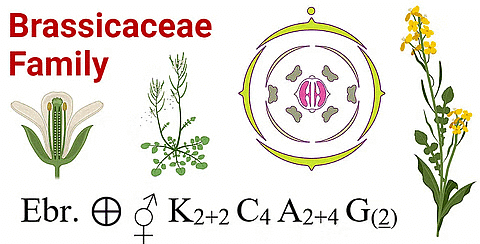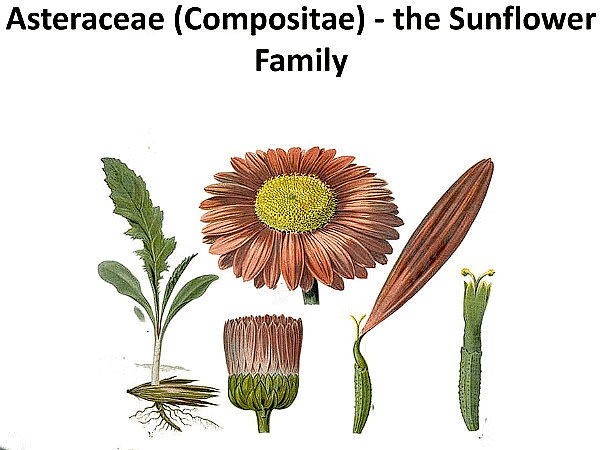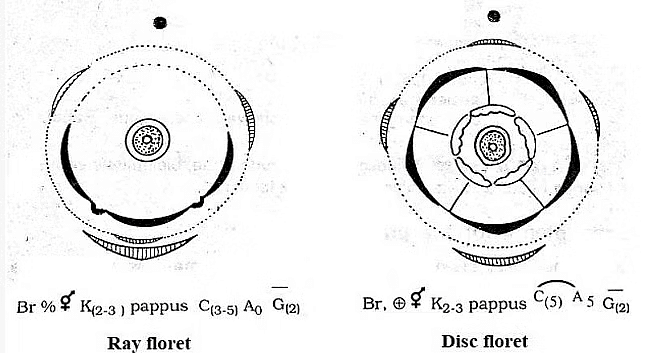Floral Families: Malvaceae, Cruciferae, Compositae and Gramineae - NEET PDF Download
What is Malvaceae?
The Malvaceae family, commonly referred to as the mallow family, is a prominent family within the order Malvales. It encompasses around 244 genera and over 4225 species. The family is distributed in tropical, subtropical, and temperate regions. Members of this family are diverse, ranging from herbs and shrubs to trees and are known for their economic importance, particularly species like cotton and various ornamental plants like hibiscus.
 Malvaceae
Malvaceae
Vegetative Characters of Malvaceae
Identifying plants means you need to know some basic structural features about important plants. This includes understanding their roots, stems, and the way their leaves look and how they're arranged.
(a) StemStems in the Malvaceae family are typically erect and can be either herbaceous or woody. They often have a hairy surface, with stellate (star-shaped) or simple hairs, which is a distinctive feature of the family.
(b) Leave
The leaves of Malvaceae plants are usually alternate, though they can sometimes be opposite. They are characteristically palmately lobed or veined and possess stipules. The leaves are generally petiolate, and the margins can be serrate, crenate, or entire.
Floral Characters of Malvaceae
(a) Inflorescenc
The inflorescence in Malvaceae is typically axillary. The flowers can be solitary or grouped in various arrangements such as cymes, panicles, or clusters.
(b) Flowe
Flowers in the Malvaceae family are usually actinomorphic (radially symmetrical) and hermaphroditic. They are often large and showy, which aids in pollinator attraction.
(c) Caly
The calyx is composed of 5 (or more) sepals, often fused at the base. An additional outer whorl of bracts, called an epicalyx, is sometimes present and can be mistaken for sepals.
(d) Coroll
The corolla typically has 5 petals, which are usually fused at the base. The petals are often brightly colored, aiding in the attraction of pollinators.
(e) Androecium
The androecium generally consists of numerous stamens. These stamens are often fused into a tube that encircles the pistil, a condition known as monadelphous.
(f) Gynoeciu
The gynoecium is typically made up of multiple carpels that are united to form a single compound ovary. The ovary is usually superior with axile placentation.
(g) Fruits
The fruit in Malvaceae can vary, but they are often schizocarps (a dry fruit that splits into single-seeded parts when ripe) or capsules.
(h) Seed
Seeds of Malvaceae plants are generally small and can be hairy or smooth. Some have endosperm, while others do not.
(i) Floral Formula
A typical floral formula for the Malvaceae family is:
 Floral Formula of Malvaceae
Floral Formula of Malvaceae
This represents a radially symmetrical flower with 5 fused sepals, 5 petals, numerous stamens fused into a tube, and a superior ovary with 5 or more carpels.
Economic Importance of Malvaceae
The Malvaceae family has a significant economic impact due to its diverse applications:
(i) Agriculture
- Cotton (Gossypium spp.) is the most economically important genus, providing the primary natural fiber for the textile industry. Okra (Abelmoschus esculentus) is widely cultivated for its edible green pods.
(ii) Ornamental Plants
- Many species, such as those from the genera Hibiscus, Malva, and Alcea, are cultivated for their attractive flowers and are used in landscaping and garden design.
(iii) Medicinal Uses
- Several members of the Malvaceae family have been used traditionally for their medicinal properties. For instance, the common mallow (Malva sylvestris) is known for its soothing and anti-inflammatory effects.
(iv) Other Uses
- Some species are used for their edible seeds and leaves, while others are utilized for their oil or as a source of natural dyes.
What is Cruciferae (Brassicaceae)?
The Cruciferae family, also known as Brassicaceae, is a significant family in the order Brassicales. It comprises about 338 genera and more than 3,700 species. The family is commonly referred to as the mustard family and is known for its economic importance, particularly for crops like cabbage, broccoli, mustard, and rapeseed. The members are predominantly found in temperate regions of the Northern Hemisphere. Cruciferae Family
Cruciferae Family
Vegetative Characters of Cruciferae
Identifying plants means you need to know some basic structural features about important plants. This includes understanding their roots, stems, and the way their leaves look and how they're arranged.
(a) Stem
The stems in the Cruciferae family are typically erect and herbaceous, although some members can be woody. They can be simple or branched and often contain watery sap.
(b) Leaves
Leaves of Cruciferae plants are generally alternate, rarely opposite, without stipules. They can be simple or pinnately compound and often have a waxy or glaucous coating. The leaf margin can be entire, toothed, or lobed.
Floral Characters of Cruciferae
Floral characters include inflorescence, Flower, Calyx, Corolla, Androciem, Gaynocieum, fruits, Seeds and floral formula. details of each character is provided below:
(a) Inflorescence
The inflorescence is typically a raceme, which is an unbranched, indeterminate type of inflorescence bearing pedicellate flowers along its axis.
(b) Flower
Flowers in the Cruciferae family are actinomorphic (radially symmetrical) and hermaphroditic. They are usually small and not very showy, with four free petals arranged in a cross, which is a distinctive feature of the family.
(c) Calyx
The calyx consists of four free sepals, which are often erect and sometimes saccate at the base.
(d) Corolla
The corolla has four petals arranged in a cross shape, hence the name Cruciferae. The petals are typically clawed at the base.
(e) Androecium
The androecium consists of six stamens, four of which are long and two are short (tetradynamous condition). This is a characteristic feature of the family.
(f) Gynoecium
The gynoecium is composed of two carpels fused to form a single compound ovary, which is superior. It typically has two locules with a false septum called a replum.
(g) Fruits
The fruit is typically a silique or silicle, which is a dry dehiscent fruit that splits open at maturity. The presence of a replum is a distinguishing feature.
(h) Seeds
Seeds are generally small, round, and can be flat or plump. They are usually not endospermic.
(i) Floral Formula
A Typical Floral Formula of Cruciferae family is:

This represents a flower with four sepals in two whorls, four petals, six stamens (four long and two short), and a superior ovary with two carpels.
Economic Importance of Cruciferae
The Cruciferae family has significant economic value due to its diverse applications:
(i) Agriculture
- Many species are cultivated as vegetables, including cabbage (Brassica oleracea), broccoli (B. oleracea var. italica), cauliflower (B. oleracea var. botrytis), and turnip (B. rapa).
(ii) Oil Production
- Some members like rapeseed (B. napus) and mustard (B. juncea) are grown for their seeds, which are a source of vegetable oil.
(iii) Ornamental Plants
- Several species are used as ornamentals, such as the wallflower (Erysimum) and stock (Matthiola).
(iv) Medicinal Uses
- Some members of the family have been used traditionally for their medicinal properties. For example, mustard seeds are used in poultices and plasters.
(v) Other Uses
- The family also includes model organisms for scientific research, such as Arabidopsis thaliana, which is widely used in plant genetics and molecular biology.
What is Compositae (Asteraceae)?
The Compositae or Asteraceae family, commonly known as the aster, daisy, or sunflower family, is the largest family of flowering plants in terms of the number of species. It includes about 1,620 genera and over 23,600 species. The family is characterized by its composite inflorescences, known as capitula or heads, which are often mistaken for single flowers. Members of this family are found in a wide range of habitats across the globe and include many ornamental plants, weeds, and crops.

Vegetative Characters of Compositae Family?
(a) Stem: Stems in the Compositae family can be herbaceous or woody, erect, prostrate, or climbing. They are often grooved and can be hollow in some species.
(b) Leaves: Leaves of Compositae plants are usually alternate, though they can be opposite or whorled in some genera. They can be simple or compound, with a wide range of shapes and margins. The leaves are often sessile or have a petiole.
Floral Characters
(a) Inflorescence: The inflorescence is a capitulum (head), which is a compact cluster of numerous small florets arranged on a receptacle, often surrounded by bracts (phyllaries) forming an involucre. Each capitulum can resemble a single flower.
(b) Flower: The florets within a capitulum can be of two types: ray florets (sterile, ligulate, and often petal-like) and disk florets (fertile, tubular). Some capitula contain only one type, while others have both.
(c) Calyx: The calyx is modified into a structure called a pappus, which can be a ring of scales, bristles, or absent. It aids in seed dispersal.
(d) Corolla: The corolla can be tubular (in disk florets) or ligulate (in ray florets). They are usually fused at the base, forming a tube or a strap-shaped structure.
(e) Androecium: The androecium typically consists of five stamens, which are fused by their anthers, forming a tube through which the style grows.
(f) Gynoecium: The gynoecium is composed of two carpels fused to form a single ovary, which is inferior. It typically has one locule with one ovule.
(g) Fruits: The fruit is an achene, which is a small, dry, one-seeded fruit that does not open at maturity. The pappus is often attached to the achene.
(h) Seeds: The seed is contained within the achene and is usually small with a thin seed coat. It lacks endosperm, as the cotyledons store the nutrients.
(i) Floral Formula
A typical floral formula for the Compositae family is:
This represents a flower with a corolla of five fused petals, five stamens fused by their anthers, and an inferior ovary with two carpels.

Economic Importance
The Compositae family has significant economic value due to its diverse applications:
(a) Food Crops
Some species are cultivated for food, including lettuce (Lactuca sativa), artichoke (Cynara scolymus), and sunflower (Helianthus annuus) for its seeds and oil.
(b) Ornamental Plants
Many species are popular ornamentals, such as daisies, chrysanthemums, asters, and marigolds.
(c) Medicinal Uses
Several members have medicinal properties, like Echinacea for immune support and Arnica for topical pain relief.
(d) Industrial Uses
Some species are used for their natural latex (e.g., rubber from Taraxacum species) and as biofuels.
(e) Environmental and Ecological Importance
Members of the Compositae family play a crucial role in ecosystems as sources of nectar and pollen for pollinators.
What is Gramineae (Poaceae)?
The Gramineae or Poaceae family, commonly known as the grass family, is one of the largest and most important plant families. It includes about 780 genera and over 12,000 species. Grasses are found worldwide in diverse habitats and are particularly known for their economic importance in agriculture. They are the primary source of calories for humans and livestock, mainly through cereals like wheat, rice, and maize.Vegetative Characters of Gramineae
(a) Stem: The stem, or culm, is typically cylindrical, hollow, and jointed, with solid nodes. It can be erect, decumbent, or creeping. Some grasses have rhizomes or stolons.(b) Leaves: Leaves are usually alternate, arranged in two ranks. They consist of a sheath that encloses the stem, a ligule at the junction of the sheath and blade, and a flat or rolled blade. The venation is parallel.
Floral Characters of Gramineae Family
(a) Inflorescence
The inflorescence is typically a spike, raceme, or panicle composed of units called spikelets. Each spikelet consists of one to many florets, each with a pair of bracts called glumes at the base.
(b) Flower
The flowers, or florets, are usually small and not showy. They lack a distinct calyx and corolla, having instead modified structures called lodicules, lemma, and palea.
(c) Calyx
The calyx is absent in grass flowers. The role of the calyx is assumed by the glumes at the base of the spikelet.
(d) Corolla
The corolla is also absent. Instead, two or three small scales called lodicules are present, which swell at flowering and help in the opening of the floret.
(e) Androecium
The androecium typically consists of three stamens, but the number can vary. The anthers are usually large and well-exposed for wind pollination.
(f) Gynoecium
The gynoecium is composed of a single carpel, forming a superior ovary. It usually has two feathery stigmas to catch pollen grains.
(g) Fruits
The fruit is a caryopsis, a type of dry fruit where the seed coat is fused to the ovary wall.
(h) Seeds
The seed is contained within the caryopsis and is usually small. It contains endosperm, which is a significant food reserve.
(i) Floral Formula
A typical floral formula for the Gramineae family is:
This represents a flower with no perianth, six stamens, and a superior ovary with two carpels.

Economic Importance of Gramineae Family
The Gramineae family has immense economic value due to its diverse applications:
(a) Food Production
Cereals like wheat, rice, maize, barley, and oats are staple foods for a large portion of the world's population.
(b) Fodder
Grasses are a primary source of fodder for livestock, providing essential nutrients for animals.
(c) Biofuels
Some grasses, like switchgrass and miscanthus, are used in the production of biofuels.
(d) Construction and Crafts
Bamboo, a member of the grass family, is used extensively in construction, furniture, and crafts.
(e) Soil Conservation
Grasses play a crucial role in soil conservation, erosion control, and land rehabilitation.
(f) Ornamental Use
Many grasses are used for ornamental purposes in landscaping and garden design.
FAQs on Floral Families: Malvaceae, Cruciferae, Compositae and Gramineae - NEET
| 1. What are the vegetative characters of Malvaceae? |  |
| 2. What are the floral characters of Malvaceae? |  |
| 3. What is the economic importance of Malvaceae? |  |
| 4. What are the vegetative characters of Cruciferae (Brassicaceae)? |  |
| 5. What are the floral characters of Cruciferae (Brassicaceae)? |  |















